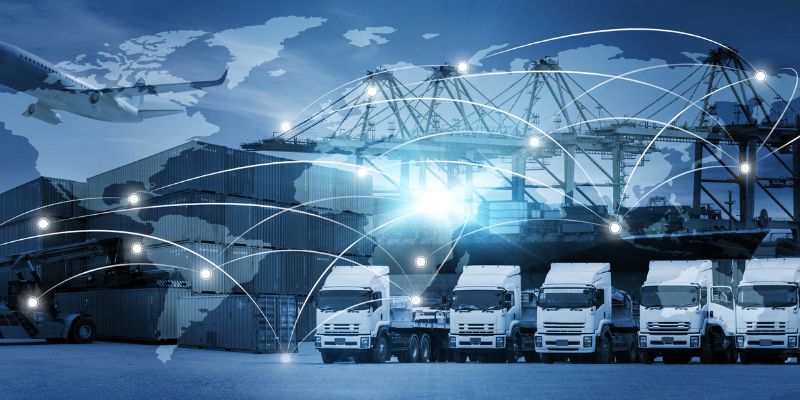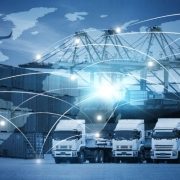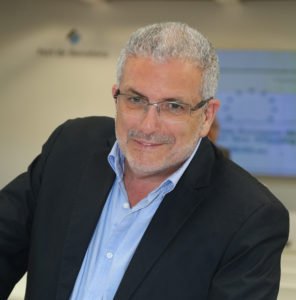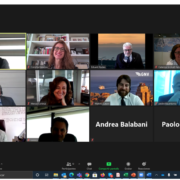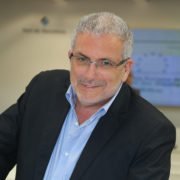
Written by: Eduard Rodés, director of the Escola Europea – Intermodal Transport
As I write this, 2021 is coming to an end. Much like 2020, it has been one for the history books. Unlike 2020, however, it has been filled with silver linings. This year, at the Escola, we have successfully expanded our operations in the Italian shores, adapted our training programmes to the digital sphere (in response to the ongoing coronavirus restrictions), and successfully created a virtual port community that allows us to mimic freight forwarding operations in door-to-door supply chains. What does all of this mean, in the greater scheme of things? I have recently written an article, which was originally published on the CETMO website (in Spanish), which considered the implications of the changing nature of our societies on the educational and professional worlds. I thought that, to close the year, it would be good to share this article with you all. I hope that you enjoy it as much as I enjoyed writing it. If you have any thoughts or comments on it, feel free to write to us – this topic (as almost anything these days) is a fluid one and welcomes varying perspectives.
Season’s Greetings and a Happy New Year to all of you who were, one way or another, influenced or affected by the Escola and our educational offers.
“Paideía – “education” in Greek – for some becomes the only task worth devoting themselves to in life. The meaning of the word becomes richer and richer, and when Romans like Varron or Cicero needed to translate it into Latin, they chose the term “humanitas”. It became the starting point of European humanism and its later radiations”.
Irene Vallejo – Infinity in a Reed: The Invention of Books in the Ancient World
A new world?
We live at a time when the model of society is evolving at an accelerated pace, leading to a rethinking of many things. We all have a certain awareness that we will have to change the way we understand our society, and that this will involve a transition that will reshape our roles, what we are able to give and what we can expect to receive. We are also aware of the need to continue educating ourselves and our children and future generations about what each of us can and should contribute to society. To understand each other and to move forward, I believe it is necessary for us to specify the points or principles from which to start. In my view, our rights are legitimised when we fulfil our obligations. In order to arrive at education, I believe it is necessary to start from experiences that will predetermine the steps to be taken.
In all the things that are changing, the first element is globalisation, and as everything becomes globalised it seems clear that the United Nations, as a body representing all nations, has an important role to play in this transition. Its role is being debated, and has been debated even more as a result of the previous belligerent US administration on many fronts. In 2017, the United States decided to abandon the Paris Agreement signed by 194 nations in 2015, which aims to keep this century’s global temperature rise to well below 2°C pre-industrial levels, and to make efforts to limit the temperature rise to 1.5°C.
Upon taking office, President Joe Biden decided to return to the pact in January 2021 with the goal of bringing the country back into the Paris Agreement and joining the growing coalition of governments, cities, states, businesses and individuals who are taking ambitious action to address the climate crisis.
It is very important that countries are able to agree on global issues in order to deal with the adverse effects that climate change is currently causing coherently. It is even more important for these efforts help mobilise cities, businesses and individuals.
This strategy must be framed within the programme of the United Nations Sustainable Development Goals for the year 2030, whose, in my opinion, global approach must be highlighted. A basic pillar is that the goals cannot be achieved in isolation and that they must all be achieved to make their success possible. This requires the involvement and commitment of everyone.
A second element is the COVID-19 pandemic. The health crisis has evolved into a global problem in which countries, hand in hand with the United Nations, have had to coordinate and fight together to fence off the attacks of the virus, which by its very nature does not respect borders. Dealing with the pandemic has brought about a radical change in living and working habits. For almost two years, the way we do things and the way we communicate has undergone a major shift. There has been a digital explosion that has substantially transformed many sectors, and these effects will forever change the way we understand relationships and work.
A third element stems from substantial changes in production and supply patterns. It became apparent that large ships can block a vital transit points in international trade, such as the Suez Canal, that there are no containers to meet shippers’ demands, and that freight rates change the basis of the cost structures on which operations were designed. The VUCA (volatile, uncertain, complex and ambiguous) environment takes over and many of the basic paradigms begin to change.
The world has suddenly become too small for us, and we are now in the process of rebuilding a new reality that will doubtlessly be different. In the 5th century BC, Athens, invaded by the Persians, sought self-awareness. In other words, it sought to rebuild a new reality, with what they called Paideia or new culture. The German philologist Werner Jaeger gave it a more precise and evocative meaning in his great work: “Paideia or the formation of Greek man”. For him, Paideia stands for an education provided both by the city and by a formal education that is in harmony with what the city teaches informally. It could be summarised as follows: we can only form (in the sense of conceiving) on the ideas by which we were formed (in the sense of modelling) … and vice versa. Commenting on Plato and Protagoras, Jaeger wrote: “the harmony and rhythm of music must be communicated to the soul so that it, in turn, becomes harmonious and obeys the rhythmic laws.” (Paideia, p.361). This training was called Areté and was given to young Athenians in three areas: physical, mental and spiritual education. As a whole, it would be what we can today call civic education oriented in the light of their virtues and their devotion to public life.
A new education?
In the development of the learning model, in which it is necessary to re-interpret the role of the student and the teacher, it is prudent to consider the characteristics that it should have in terms of its possibility of adapting to the scenarios in which the education is to be carried out. In the course of the last decades there has been an evolution from a type of education called behaviourism to a new one called constructivism.
The conductive (behaviouralist) model is governed by a pre-set programme in which the teacher is the guide and instructor and the pupil is merely the recipient of this knowledge. This model was predominant until the middle of the last century.
From the end of the 20th century onwards, the constructivist model was developed, based mainly on the ideas of the Swiss epistemologist Jean Piaget. In the constructivist model, the protagonist is the learner, who plays an active role and must construct his or her own learning. The teacher in this case is a facilitator who guides and facilitates knowledge. The very dynamic of the learning process is action-oriented, which favours its application in the business world.
In the case of projective education, learning is based on the creation of projects and the student must develop his or her research potential and put his or her conclusions into practice, using theory as one of the tools for their realisation.
The Escola Europea, since its inception, has been committed to a hybrid model based on constructivism and projectivism through practical experiences with our means (transport equipment and infrastructures) and the use of digital tools. This is attempt to respond to the new reality to be built in which the student is the protagonist of the learning process and in which practice is combined with the development of social skills such as teamwork, conflict resolution, negotiation skills, rhetoric and public speaking. Digitalisation plays a fundamental role, as it allows us to create virtual worlds that mirror physical realities at a negligible cost. The tools that have been developed in recent years mainly for driving vehicles, especially expensive ones (planes, ships, trains, space shuttles, etc.) are now entering the world of business and operations. Information and Communication Technologies (ICT) are becoming fundamental resources for education.
The YEP MED Project, which began in 2020 under the framework of the ENI-CBC MED Programme of the European Union, has entered this new territory through the creation of the portvirtuallab.com platform in which a Logistics-Port Community made up of avatars of the companies that comprise it makes the simulation of operations between the different operators in door-to-door transactions in international trade possible. The contents have focused on the management of sustainable import and export operations in international trade from the perspective of a freight forwarding company. With this approach, it was necessary to understand the door-to-door operations and the entire logistics chain to be served, its external costs, passing through the ports and their operators: terminals, consignees, port authorities, customs, etc. The result has been surprising for everyone, as it has allowed the parties to reproduce operations that are practically identical to those from the real world, albeit in a virtual business environment. What started as a problem – with the forced implementation of e-learning as a consequence of the closing of all borders – has turned into an opportunity and the start of a new generation of simulation-based educational tools.
This opens up new training perspectives in which students can build their own training by carrying out projects on the import and export of goods, in which they have to collaborate in teams with students from other countries in order to successfully complete their operations – all from the convenience of their computers. The teachers become tutors and accompany them in the work of constructing the proposals and in carrying out the scaffolding to achieve the success of the projects to be carried out by each team. This teamwork, which corresponds to the current reality of companies, is a fundamental part of the learning process.
New professional profiles?
Education must respond to the challenges that societies face. Digitalisation, sustainability, English, the circular economy, blue skills… We have had a sabbatical year (actually six months) so to speak – one that made us rethink an important part of the educational strategies and forced us to take a major leap forward. As the young people in Spain would say, we have skipped four screens – by-passed many steps accelerated further by the challenging circumstances of the past two years.
All these elements, which were already important, have become critical for all companies in the sector. Digitalisation became a major element in the design of solutions. The internationalisation of the economy has become a fundamental element of progress in our economy for the well-being of our region. The environment is becoming a critical and discriminating element in terms of the viability of operations, becoming a fundamental part of the configuration of all the elements involved in the sector; from infrastructures to the design of products, taking into account the distribution processes and their recycling. These gave rise to so-called Multi-Local companies – small multinationals that export to and from innumerable countries. This calls for a new culture and a new way of doing things. To make this accelerated transition possible, adequate and easily accessible training will be necessary.
The MEDPorts Association carried out a study to identify professions that are needed in ports but which are not yet covered and in some cases not existing. The results were combinations of the requirements described above oriented to specific areas:
| Algorithm expert
The responsibility of this expert will be to analyse information and evaluate results in order to choose the best solution and solve problems using algorithms. He/she/they will be an expert in algorithm design and software development.
|
Head of cyber security
Their primary responsibilities will be to protect Port Authorities by developing security-focused strategies, effectively integrating and managing new or existing technology systems to deliver continuous operational improvements, and detect, respond to and mitigate threats. This role will require a deep understanding of cyber security capabilities including security and privacy strategies and governance, IT risks, security testing, technology implementation/operations and cyber crime.
|
| Drones expert
This expert will be responsible for operating, testing and repairing drone devices to be used in a port. This role will require extensive knowledge of robotics.
|
Legal IT expert
This expert will analyse information and evaluate how to find the best/most creative solutions within the framework of the law and take advantage of the possibilities offered by new IT developments.
|
| Robotisation/automation expert
They will be responsible for planning, implementing and coordinating the progress of automation and robotics projects in port authorities. He/she will also provide judgement and analysis for the design, development and implementation of plans and procedures related to automation and robotics in ports. This profile may include a mechanical version that will have to build, install, test or maintain robotic equipment or related automated production systems.
|
|
Environmental Area
| Energy transition manager
This manager will be responsible for the development of tailor-made energy transition plans in port authorities that will bring significant environmental and economic benefits. They should have the research and innovation capacity to find the best solutions to improve efficiency and environmental performance.
|
Waste management expert
This person will plan, implement and coordinate waste management systems designed to maximise opportunities for waste prevention, reuse and recycling. They will provide guidance to improve efficiency, while addressing issues of sustainable waste collection, disposal, resource management and other related special features, including waste avoidance strategies at ports.
|
Cruise & city-port area
| City-port relationship manager
Managing the city-port relationship more strategically is now fundamental for ports. It is one of the most important challenges facing city ports today. This professional will have the responsibility to show the way forward to transform the city-port relationship into a more productive one. They will have to lead the re-evaluation of the city-port relationship that questions everything from the structure of the port authorities to what the realistic expectations of their stakeholders should be.
|
Cruise and tourism marketing director
The responsibility of this professional will be to promote the Port Authority as a preferred cruise destination and to achieve the planned growth and development of the sector. Close coordination with the city’s tourism managers will be essential. In carrying out this function, the Cruise and Tourism Marketing Manager will have to interact with the main partners in the private and public sector.
|
Other
| Cold chain supply expert
Due to the increasing relevance of cold chain traffic, the position of cold supply chain expert will be needed to ensure the functioning of cold supply chains in ports. To do so, the supply chain expert will have to monitor stocks and orders as well as forecast future supply needs. This function combines analysis and reporting to ensure smooth transit of goods through the ports.
|
Emergency manager
The main duty of this post will be to protect and preserve security in the port. Responsibilities include coordinating emergency response efforts and ensuring that the emergency authorities’ plans are properly implemented.
|
| Expert in intelligent energy networks (Smart grids)
Smart grid engineers are responsible for designing systems that can regulate smart grids and make them work efficiently. The main focus of their work will be to improve energy distribution by making power grids more efficient. Their job will be to develop design plans and evaluate the effectiveness of these designs.
|
Intermodal network manager
This manager will be a key contributor to the Port Authorities’ strategy. This position is a key element for any business where freight transport is essential. It will coordinate the main intermodal networks of the ports and ensure their efficiency and fluidity.
|
| Public-private partnership manager
The main function of this manager will be to lead and support the creation of policies, strategies and programmes to accelerate private sector development and public-private partnerships (PPPs) in ports. They will also be involved in the development, structuring and delivery of PPP projects as well as port cooperation initiatives with public-private components. They will work directly with governments, private sector investors and financial institutions.
|
|
This exercise of identifying new profiles could be done with all types of companies in the sector, and the results would undoubtedly be remarkable. This leads us to a disturbing reflection: are there teachers and training programmes to teach these subjects?
From the Escola’s experience we know that there are teachers who, by making an effort to adapt, can begin to prepare the contents and materials with the collaboration of the educational centres and, increasingly, the developers of training software. The Escola has recently carried out the first course of the programme derived from this study, dedicated to energy transition in port authorities. To prepare this course has not been an easy task and required the help and involvement of many experts.
What will we have to change?
A new society, with a new education, for new professional profiles necessarily leads us to the question of how training centres, their teachers and the students themselves will have to evolve. In a world in which the speed of change is constantly accelerating, it is necessary to build a model that allows rapid adaptation to these changes, at the risk of others being able to do so more efficiently, which could mean a significant competitive disadvantage.
The necessary adaptation process is not the result of individual action. It must necessarily involve a shared and synchronised strategy that must anticipate the general changes that may occur and how to deal with them well in advance.
A major part of this must involve joint collaboration between companies, knowledge centres and public administrations, which must be capable of adapting to the changes so that there are no distortions in the development of companies and in working conditions.
Collaboration and coordinated work by all the actors in order not to miss the boat. The development of the MEDPorts Partnership training programme would be a good example. Four training centres from four different countries have agreed to develop courses to start training in the profiles described. All the centres are directly involved in some of the content prepared by the other centres. This makes it possible to prepare a significant volume of training material in a relatively short period of time. Ports that compete with each other collaborate in training, and this is a powerful message for society.
Conclusions
Communities that progress are those that are able to adapt and learn. Those that have the ambition to progress, which build on principles based on values, must first accept that today almost everything remains to be learned. We must build a new world with new tools. We are facing energy, economic, digital, social and many other transitions. Each change will require new knowledge and new skills. It is the time for training, and this training must become part of our daily reality.
In the Mediterranean, the port sector must be a driving force for change. It must encourage and facilitate the processes of digitalisation, innovation, social, environmental and economic sustainability. The future will heavily depend on the ability to exchange goods and services, and goods will largely have to pass through ports. A very high percentage of companies will be influenced by the efficiency of their operators. Proper education and training is essential to help us achieve this. If it takes the creation of numerous specialised training centres, let us do it to make it possible.
